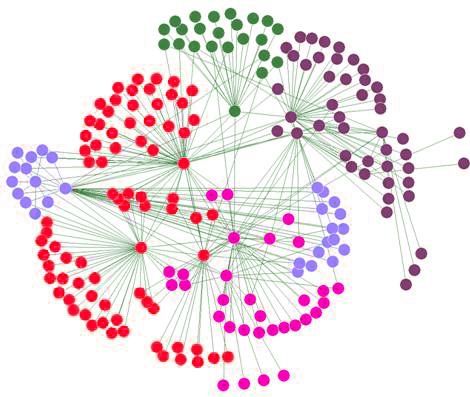Archive for the ‘mobile phones’ category: Page 213
Jun 14, 2016
Android inventor Andy Rubin thinks the future of smartphones might be a single AI
Posted by Klaus Baldauf in categories: computing, mobile phones, quantum physics, robotics/AI
Andy Rubin, who co-founded Android and jump-started Google’s robotics efforts, imagines a future where artificial intelligence is so powerful that it powers every connected device. Speaking at Bloomberg’s Tech Conference in San Francisco today, Rubin said a combination of quantum computing and AI advancements could yield a conscious intelligence that would underpin every piece of technology. “If you have computing that is as powerful as this could be, you might only need one,” Rubin says. “It might not be something you carry around; it just has to be conscious.”
It sounds outlandish and theoretical, and it is. But Rubin, with his investment fund Playground Global, is investing in companies trying to make that kind of wondrous future a reality. One such company, a quantum computing firm Rubin would not name, is composed of researchers he thinks may one day commercialize quantum devices using standard manufacturing processes. Quantum computing promises exponential boosts in processing power, in part by harnessing the probabilistic nature inherent to the physics discipline.
Rubin thinks there’s substantial overlap coming down the line for quantum computing, AI, and robotics. “In order for AI to blossom and fulfill consumer needs, it has to be about data,” he says. “That’s where robotics come in — robots are walking mobile sensors, who can sense their environment and interact and learn from those interactions.” Furthermore, Rubin adds, both AI and quantum computing are good at pattern matching and could greatly complement one another. “Those two things combined in hundreds of years might get us to the point of this conundrum, who is the master and who is the servant and all that,” he says.

Everything is getting easier, faster and lighter. The world as we know it, is dematerializing.
Jun 9, 2016
Now you can upload photos to Facebook with 360-degree views
Posted by Shailesh Prasad in categories: mobile phones, virtual reality
Facebook launched a feature that allows users to upload photos with 360-degree views on Thursday.
Apart from photos taken from 360-degree cameras, panoramic photos taken on a mobile phone can be converted to a 360-degree view on the newsfeed, the company said on Thursday.
The photos can also be seen in virtual reality compatible devices, Facebook said.
Continue reading “Now you can upload photos to Facebook with 360-degree views” »
Jun 9, 2016
Lenovo unveils augmented reality smartphone using Google’s Project Tango
Posted by Karen Hurst in categories: augmented reality, mobile phones
Jun 8, 2016
Your phone may soon sense everything around you
Posted by Karen Hurst in categories: augmented reality, mobile phones
SAN FRANCISCO (AP) — Suppose your smartphone is clever enough to grasp your physical surroundings — the room’s size, the location of doors and windows and the presence of other people. What could it do with that info?
We’re about to get our first look. On Thursday, Lenovo will give consumers their first chance to buy a phone featuring Google’s 3-year-old Project Tango, an attempt to imbue machines with a better understanding about what’s around them.
Location tracking through GPS and cell towers tells apps where you are, but not much more. Tango uses software and sensors to track motions and size up the contours of rooms, empowering Lenovo’s new phone to map building interiors. That’s a crucial building block of a promising new frontier in “augmented reality,” or the digital projection of lifelike images and data into a real-life environment.
Continue reading “Your phone may soon sense everything around you” »
Jun 8, 2016
Future humans: Immortal, jobless and genius
Posted by Montie Adkins in categories: augmented reality, biotech/medical, computing, cyborgs, drones, internet, life extension, mobile phones, virtual reality
What will we do when money has no meaning? And if everyone gets life extension what will today’s mega rich think and/or do about it?
May you live in interesting times – A curse, origin unknown
One of the ‘curses’ usually attributed to ancient China, but frequently thrown around in today’s society is ‘May you live in interesting times’, suggesting that living in turbulent times, no matter the cause, is somehow a bad thing.
Continue reading “Future humans: Immortal, jobless and genius” »
Jun 7, 2016
Want to know what the future of medical invention looks like? Read on
Posted by Karen Hurst in categories: 3D printing, biotech/medical, business, computing, cyborgs, food, habitats, mobile phones, singularity, transportation, wearables
Medical/ Biocomputing will only continue to grow and advance as a result of the demand for more improved experiences by consumers and business in communications and entertainment, food, home life, travel, business, etc.
Today, we have seen early opportunities and benefits with 3D printing, BMI, early stage Gene/ Cell circuitry and computing. In the future, we will see these technologies more and more replaced by even more advance Biocomputing and gene circuitry technology that will ultimately transform the human experiences and quality of life that many like to call Singularity.
Printing technology has come a long way from screechy dot-matrix printers to 3D printers which can print real life objects from metals, plastics, chemicals and concrete. While, at first, 3D printers were being used to create just basic shapes with different materials, more recently, they have been used to create advanced electronics, bio-medical devices and even houses.
Aircraft manufacturer Airbus recently showcased the world’s first 3D-printed mini aircraft, Thor, at the International Aerospace Exhibition and Air Show in Berlin. Although Airbus and its competitor have been using 3D-printed parts for their bigger assemblies, recent attempt shows that aviation may be ready for a new future with much lighter and cheaper planes given 3D printing not only cuts down the costs with less wastage, it also makes the plane lighter, thereby making them faster and more fuel efficient. But planes and toys is not what 3D printing might be restricted to; though in the elementary stage at the moment, the technology is being used for creating complex electronics like phones and wearables and may be able to reduce costs for manufacturers like Samsung and Apple.
Continue reading “Want to know what the future of medical invention looks like? Read on” »
Jun 6, 2016
Walking and talking behaviors may help predict epidemics and trends
Posted by Karen Hurst in categories: biotech/medical, information science, mathematics, mobile phones
Wow!
Mobile phone data may reveal an underlying mathematical connection between how we move and how we communicate that could make it easier to predict how diseases—and even ideas—spread through a population, according to an international team of researchers.
“This study really deepens our quantitative understanding of human behavior,” said Dashun Wang, assistant professor of information sciences and technology, Penn State. “We would like to think that we control our own behavior and we can do what we want to do. But, what we are starting to see with big data is that there is a very deep regularity underlying much of what we do.”
Continue reading “Walking and talking behaviors may help predict epidemics and trends” »














